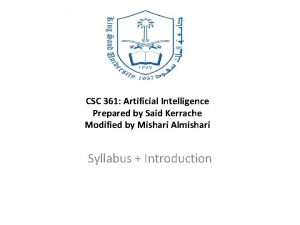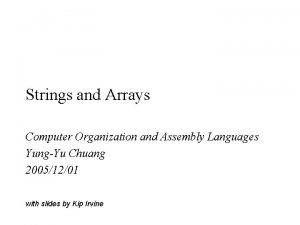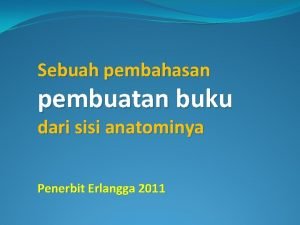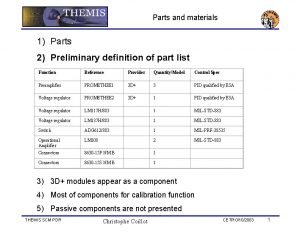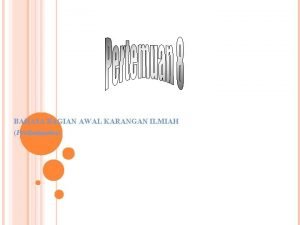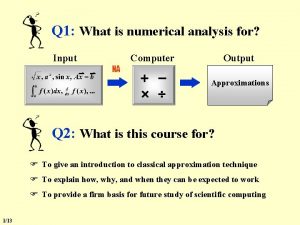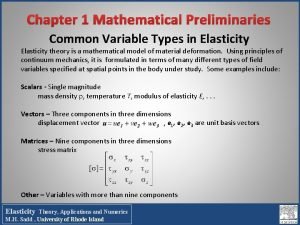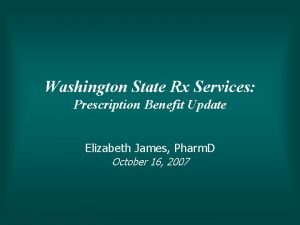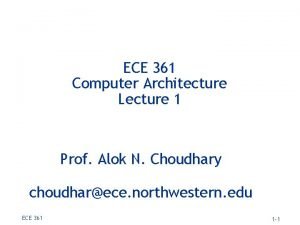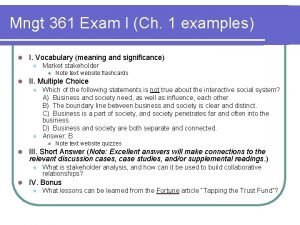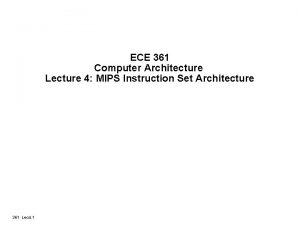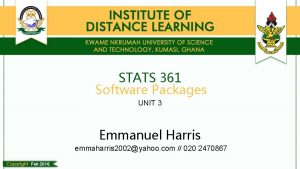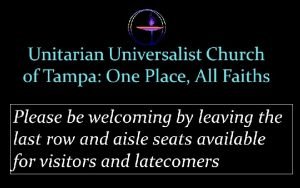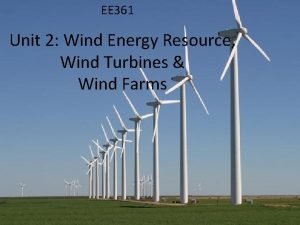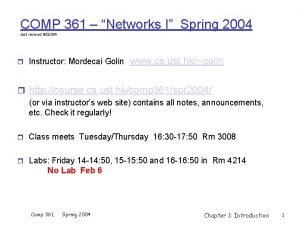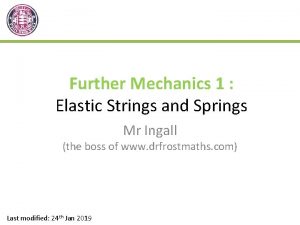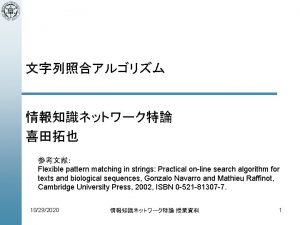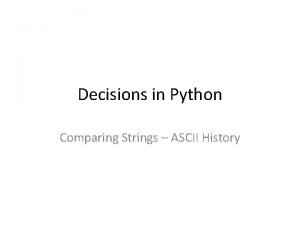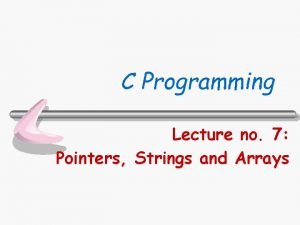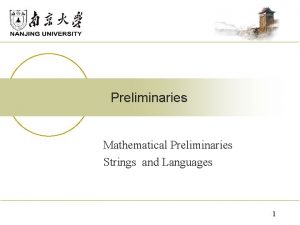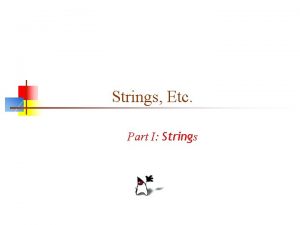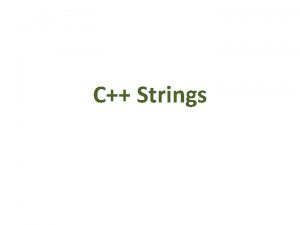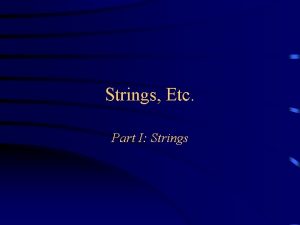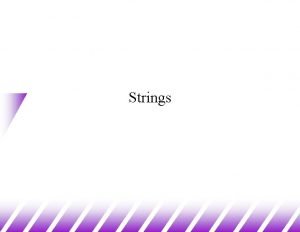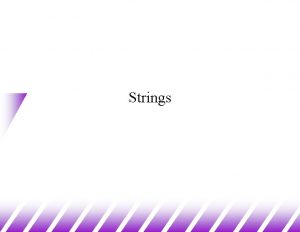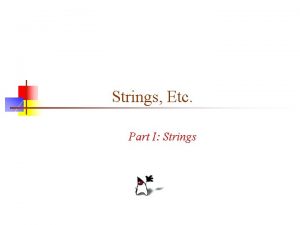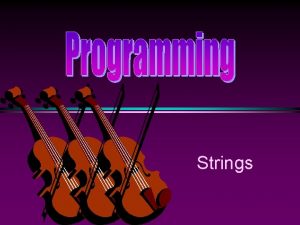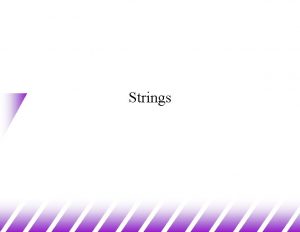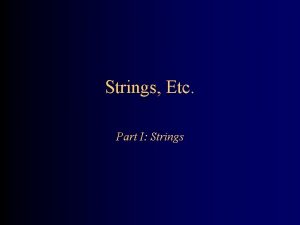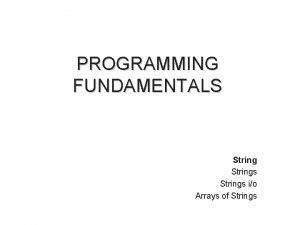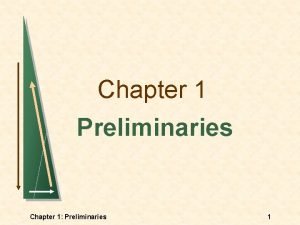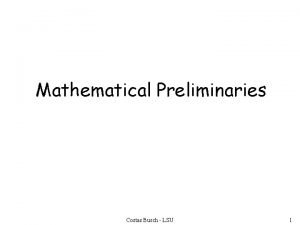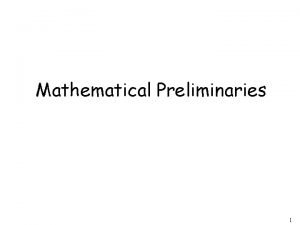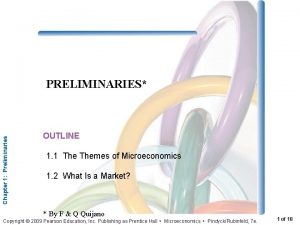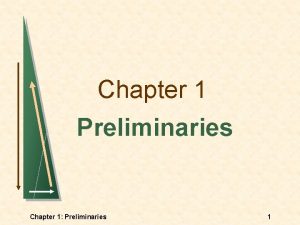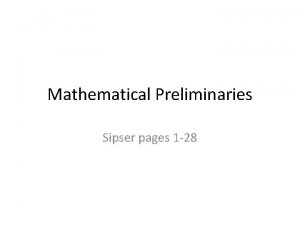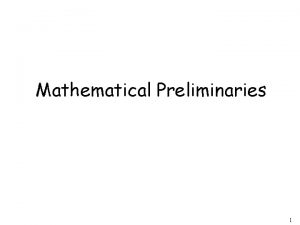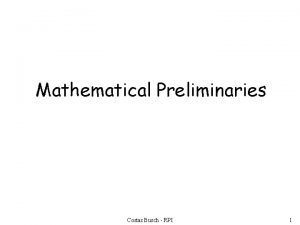Preliminaries Language Set of Strings CSC 361 Preliminaries

























- Slides: 25

Preliminaries Language: Set of Strings CSC 361 Preliminaries 1

n Specification and recognition of languages n Sets n n n Strings n n Operations Defining sets (inductively) Proving properties about sets (using induction) Defining functions on sets (using recursion) Proving properties about functions (using induction) Operations Languages : set of strings n CSC 361 Operations Preliminaries 2

Representation of Sets n Set: collection of objects n Finite : can use enumeration n n E. g. , {a, b, c} Infinite : requires describing an infinite characteristic of members using finite terms n CSC 361 E. g. , { n e N | even(n) / square(n) } Preliminaries 3

Sets: Examples • Sets are denoted by { <collection of elements> } • Examples: v{0, 1, 2, …} “the empty set” “the set consisting of the elements a and b” “the set consisting of the empty set” “the set consisting of the first 100 natural numbers” “the set consisting of all natural numbers” v{0, 2, 4, …} v{2 n | n } “the set of all natural pair numbers” v{} v{a, b} v{{}} v{1, 2, …, 100} CSC 361 Preliminaries 4

Operations on Sets Set Inclusion and Set Equality Definition: • Given 2 sets, A and B, A is contained in B, denoted by A B, if every element in A is also an element in B True or false: v{e, i, t, c} {a, b, …, z} true v for any set A, A A true v for any set A, A {A} false Definition: • Given 2 sets A and B, A is equal to B, denoted by A = B, if A B and B A CSC 361 Preliminaries 5

Operations on Sets n Review: n n n Member Union Intersection Subset Powerset Cartesian product CSC 361 Preliminaries 6

Operations on Sets n Set Difference n De. Morgan’s Laws CSC 361 Preliminaries 7

Operations on Sets Cartesian Product • Definition: Given two sets, A and B, the Cartesian product of A and B, denoted by A B, is the following set: {(a, b) | a A and b B} pair or 2 -tuple Examples: • What is: {1, 2 , 3} {a, b} = {(1, a), (1, b), (2, a), (2, b), (3, a), (3, b)} • True or false: {(1, a), (3, b)} {1, 2 , 3} {a, b} true • True or false: {1, 2, 3} {1, 2 , 3} {a, b} false CSC 361 Preliminaries 8

Operations on Sets Cartesian Product of More Than 2 Sets Definition: Given three sets, A, B and C, the Cartesian product of A, B, and C denoted by A B C, is the following set: {(a, b, c) | a A, b B, c C} Triple or 3 -tuple Definition. (x, y, z) = (x’, y’, z’) only if x = x’, y = y’ and z = z’ These definitions can be extended to define the Cartesian product: A 1 A 2 … An and equality between n-tuples CSC 361 Preliminaries 9

Operations on Sets • Some Cartesian product problems to try out: • What is: {1, 2 , 3} {a, b} { , } = • What is the form of the set A B C D • What is the form of the set A B (C D) • What is the form of the set (A B ) (C D) CSC 361 Preliminaries 10

Partition of a Set X The set of subsets of X is a partition of X (1) “covers all subsets” (2) “pair-wise disjoint” iff Collectively Exhaustive / Mutually Exclusive CSC 361 Preliminaries 11

Examples n Set of Natural numbers is partitioned by “mod 5” relation into five “equivalence classes”: { {0, 5, 10, …}, {1, 6, 11, …}, {2, 7, 12, …}, {3, 8, 13, …}, {4, 9, 14, …} } n “String length” can be used to partition the set of all bit strings. { {}, {0, 1}, {00, 01, 10, 11}, {000, …, 111}, … } CSC 361 Preliminaries 12

Relations Definition: Given two sets, A and B, A relation R is any subset of A B. In other words, R A B • Relations are used to describe how elements of different sets interact v. Question: What does the relation A B indicate? v. Examples of relations Simple: • {(c, s) | c is a class at KU, s is a student at KU, AND s is in C } CSC 361 Preliminaries 13

Relations Example: Let I be the set of all classroom instructors at Kutztown n Let S be the set of all students at Kutztown n Then, we can define the relation Students of an Instructor, over I x S, as follows: Students of an Instructor= {(i, s) | i I, s S, s is in a course of instructor i} Questions: 1. Does this relation represent an equivalence relation? 2. Suppose this instructor teaches courses c 1, c 2, and c 3. Would the sets Students in instructor i’s course, for courses c 1, c 2, and c 3, be disjoint? n CSC 361 Preliminaries 14

Equivalence Relations A relation R is an equivalence relation if R is reflexive, symmetric, and transitive Relation R is: • reflexive if (a, a) R for each a in the language • symmetric if when (a, b) R then (b, a) R • transitive if (a, b) R and (b, c) R, then (a, c) R Equivalence relations are generalizations of the equality relation x {(1, 2), (1, 3), …, (2, 3), (2, 4), …} “the relation x < y” {(a, b) | a and b are males between 35 and 40 years old} CSC 361 Preliminaries 15

Functions Definition: A function f from a set A to a set B, denoted by f: A B , is rule of correspondence between A and B such that there is a unique element in B assigned to each element in A i. e. for each a A there is one and only one b B such that (a, b) f Note: • A is the domain of f • B is the range of f Question: Is the following relation also a function from the set of KU classes to the set of KU students? {(c, s) | c is a class at KU, s is a student at KU, AND s is in C } CSC 361 Preliminaries 16

Functions n Kinds of Functions n Total n n One to one (injection) n n CSC 361 Total, and each mapping from domain to range is unique Onto (surjection) n n All domain elements map to an element in the range All elements of the range are mapped to from a domain element 1 -1 & Onto (bijection) Preliminaries 17

(Total) Function Domain Co-domain ( A Range) B f CSC 361 Preliminaries 18

One to One Function (injection) Domain Co-domain ( A Range) B f CSC 361 Preliminaries 19

Onto Function (surjection) Domain Co-domain ( A Range) B f CSC 361 Preliminaries 20

1 -1 Onto Function (bijection) Domain Co-domain ( A Range) B f CSC 361 Preliminaries 21

Inductive Definitions n Constructive n Example n Set of natural numbers N = {0, 1, 2, 3, …} n Finite representation in terms of Seed element: zero Closure Operation: successor function {0, s(0), s(s(0)), s(s(s(0))), …} n Imposes additional structure on the domain. CSC 361 Preliminaries 22

n n n Basis case: Recursive step: Closure: only if it can be obtained from 0 by a finite number of applications of the operation s. (* Minimality condition to uniquely determine N *) CSC 361 Preliminaries 23

Languages n n A language can be specified as a set of strings. Languages are classified by how they can be formed n n Regular languages are the most constrained Others n n n CSC 361 Context-free Context-sensitive Recursively enumerable Preliminaries 24

Language Semantics - Syntax n Regular sets/languages n Generator n n Recognizer n n Regular Expressions, Regular Grammars Finite State Automata Context-free languages n Generator n n Context-free Grammar Recognizer n CSC 361 Push-down Automata Preliminaries 25
 Said kerrache
Said kerrache Total set awareness set consideration set
Total set awareness set consideration set Training set validation set test set
Training set validation set test set Array of strings assembly
Array of strings assembly Apa itu preliminaries
Apa itu preliminaries Preliminary material
Preliminary material Apa itu preliminaries
Apa itu preliminaries Mathematical preliminaries in numerical computing
Mathematical preliminaries in numerical computing Chapter 1 mathematical preliminaries
Chapter 1 mathematical preliminaries Adapted synoynm
Adapted synoynm 8883611611
8883611611 Computer architecture
Computer architecture Mngt meaning
Mngt meaning Wap 361
Wap 361 Ece 361
Ece 361 Stats 361
Stats 361 Hymn 361
Hymn 361 Ee-361
Ee-361 Ece 361
Ece 361 Comp 361
Comp 361 Import java.util.string
Import java.util.string Spring problems mechanics
Spring problems mechanics Image search reverse
Image search reverse Rate of energy transfer by sinusoidal waves on strings
Rate of energy transfer by sinusoidal waves on strings String ascii python
String ascii python Pointers and strings
Pointers and strings
